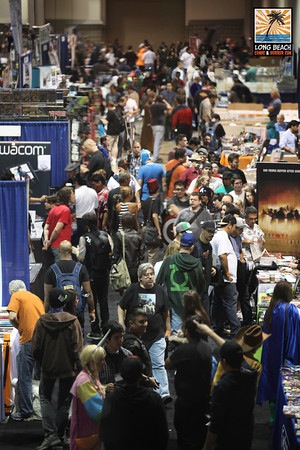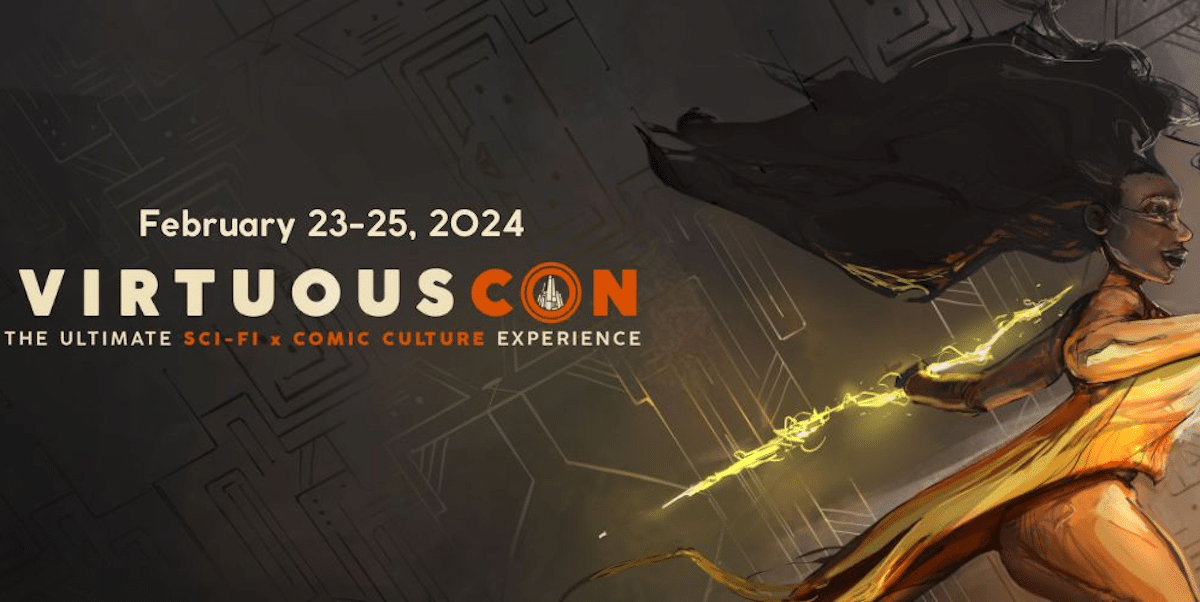by Mike Scigliano
[continuing show runner Mike Scigliano’s explanation of how to put on a comics show, esp this very weekend’s LONG BEACH COMICS EXPO]
By now you’ve gone through all the hard work involved with the pre-production of your comicon. You have a venue and dates for your show. You’ve got a floor plan design that you feel happy about AND was approved by the fire marshal. The next step in the process is to begin to promote and pitch your show to potential exhibitors.
By “exhibitors,” I mean publishers, small press publishers, retailers, artist alley creators (artists, writers, inkers, colorists, painters, etc) and whoever else you feel might be a fit or want to exhibit at your comicon. For Long Beach Comic & Horror Con we place a specific emphasis on comics and their creators in our Artist Alley. That emphasis varies from comicon to comicon, of course, but for us it was a must.
As I touched on in my last column about floor plans, Artist Alley is a very important part of the show floor. We have it placed pretty much smack dab in the center of the floor and it features over 154 available tables dedicated to creators. Therefore, when I am talking to a potential Artist Alley exhibitor I talk about our dedication to the backbone of the comic books industry — its creative talent. I talk about our pricing, which is relatively affordable, and what you get for your money. In our case you get a table, two chairs, two exhibitor badges and listings in both our website and printed exhibitor lists. I’ll certainly answer any questions that might arise.
One thing I always do is remind them about the rules in our Artist Alley. No visible nudity. It’s a family event. No massive engineered backdrops. It’s Artist Alley. One of the last rules I will mention is that they are credited as an individual ONLY. Artist Alley tables cannot be credited as a company. If they really want to use the elaborate back drop I steer them towards our small press booths and explain the benefits of upgrading to a full 10 foot by 10 foot small press set up such as more room, four badges instead of two and the ability to credit yourself as a company not just as an individual creator.
Retailer booths are a little bit different. A retailer booth is 10 feet by 10 feet square and includes a table, two chairs and four exhibitor badges. It’s very often cheaper to bring your own extra tables and chairs. I will suggest this to help save the exhibitor on their expenses. When I talk to a potential retail exhibitor for the first time I will ask about what they sell. If you are cold-calling a potential exhibitor, do your homework ahead of time and know what they sell BEFORE you call them. Being prepared goes a long way. You need to get to know the exhibitor to have an idea of how they will fit in. They may ask questions like “Are there a lot of toy dealers?” or “How many gold/silver age comic dealers do you have?” You have to be able to answer these types of questions and answer them truthfully. Once you understand your potential exhibitor it becomes easier to pitch your comicon to them.
Publishers and other types of exhibitors are a different type of pitch. Retailers are more interested in primarily selling products or creating an awareness if they have a local brick and mortar store. Publishers strike a balance between sales and marketing. They need space for products, signage and very often creator signings. They also tend to have more elaborate displays as well. You need to cater your pitch to match these needs. For example when I pitch comic book publishers I will talk about our focus on comics. I’ll discuss the possibility of hosting a panel and other marketing options available. For studios I’ll talk about signing or screening opportunities. They are all about marketing. Essentially, you need to be able to explain what your comicon can offer and how a mutually beneficial relationship can be created by them exhibiting at your show.
For LBCHC, Show Management had over a decade of experience and contacts to utilize when we started the show in 2009. We weren’t starting from scratch, and we had a solid base to work with. Once we exhausted that base, we began the process of cold-calling local comic book retailers, posting about the show on art-themed websites, getting press releases out to the public, linking up with other shows and cross-promoting to their exhibitor list, and so on.
The most important thing to do when pitching your comicon is to be honest and truthful. Don’t inflate your attendance. Don’t knock other shows. Don’t be disingenuous. Don’t make promises that you know you can’t follow through on. People see through it all and more often than not any lies — even ones you might consider white lies — come back to bite you in the end. If you are passionate about your comicon and pitch it well, you’ll have a good chance of filling up your show floor with all sorts of great exhibitors.
-scig!









@Mike Scigliano: I love the idea of artists alley in the center. And I love the view of “dedication to the backbone of the comic books industry — its creative talent.”
I’ve done many comicons over the years, and so many of the big cons are about comics in name only. Man list celebrities and then a few comic artists as an afterthought.
I’m launching my first comic convention this Saturday in Asbury Park, and we’re already planning for a bigger venue for next year, but we’ll always keep the focus on the creators. Otherwise why bother?
LBCC is a great Con that I’ve been going to the last couple years with a fun emphassis on comics AND creators/artists compared to SDCC. The only knock I’d have to say about it is the on-site booth to pick up tickets gets jammed up with only a couple people handling the pre-registered attendants thus I noticed that walk-up ticket buyers getting their tix in-and-out quickly while those who registered online having to wait 20-40 mins. in a long line.
Any change of getting Marvel or DC to finally set-up at this year’s LBCC like they did at Wonder Con?
Scigliano’s information comes across really well. I like his stress on being honest, to build a solid rapport for future business.
I wonder how he handles the placement of artists, and exhibitors. Does he try to space out the big guys so the crowds do not all congregate in one specific area? Or is it first come, first serve?
@CitizenCliff – Thanks! I have heard some good buzz about your show. Good luck! We certainly need more good comicons all over.
It’s true. Without the talent, there are no comics. Bottom line.
@MarkyD – Thanks! We addressed that exact issue by working with a ticketing company. They are providing us with a great set of tools to keep the lines moving. We can even gran an app, log in and check people in via a smartphone if we have to. We want to get people into the show as fast as we can. Everyone hates lines. I know I do. I think you will like the change for this year’s show.
As for Marvel and DC. We certainly would love to have them at the show. We’ll see how it goes. In the mean time, we’ve got some great comic publishers on board already for 2012. Keep an eye out in the next few weeks for the first announcements.
@Al – Thanks. I really feel that being truthful and transparent with people is the way to go. Like I said, it WILL bite you in the end if you aren’t. We see it time and time again at comicons. Just take a look at the archives here on the Beat.
As for placement, you are on the right track. We do have a specific plan in mind during the layout process that is designed to help keep a healthy flow of traffic. I’ll be doing an entire column devoted to placement and the strategy behind it in the future. There’s a lot of factors that go into placement.
Thanks for the comments, guys. Keep them coming as I am happy to discuss the column each week!